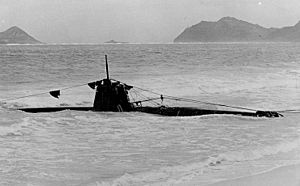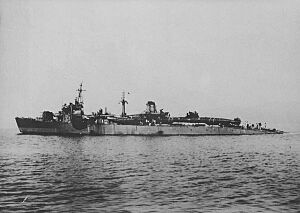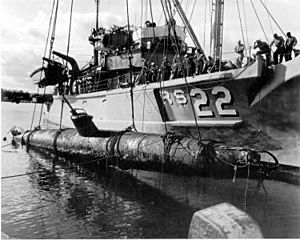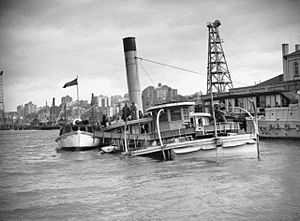Type A Kō-hyōteki-class submarine facts for kids

Type A Ko-hyoteki-class submarine, No.19, grounded in the surf on Oahu after the attack on Pearl Harbor, December 1941
|
|
Quick facts for kids Class overview |
|
|---|---|
| Operators: | |
| Completed: |
|
| General characteristics | |
| Type | Kō-hyōteki kō-gata (甲標的甲型, Target 'A', Type 'A') class midget submarine |
| Displacement | 46 long tons (47 t) submerged |
| Length | 23.9 m (78 ft 5 in) |
| Beam | 1.8 m (5 ft 11 in) |
| Height | 3 m (9 ft 10 in) |
| Propulsion |
|
| Speed |
|
| Range |
|
| Test depth | 30 m (98 ft) |
| Complement | 2 |
| Armament |
|
| Notes | Ballast: 2,670 kg (5,890 lb) in 534 × 5 kg lead bars |
The Type A Ko-hyoteki (甲標的甲型, Kō-hyōteki kō-gata, Target 'A', Type 'A') class was a group of small Japanese midget submarines. They were used during World War II. These submarines had hull numbers but no names. People often called them by the number of the larger submarine that carried them. For example, the midget submarine carried by the I-16 was known as "I-16's boat."
After the Type A, Japan built other similar submarines. These included the Type B, Type C, and Type D. The Type D was also known as Kōryū.
Contents
History of the Midget Submarines
Fifty of these submarines were built. They were called "A Target" as a trick. If enemies found out about them too early, the Japanese Navy could say they were just practice targets. They also had nicknames like "Tubes" or "Target."
The first two submarines, No.1 and No.2, were only used for testing. They did not have a conning tower (the small tower on top). Later submarines had conning towers to help them stay stable underwater.
One famous submarine, No.19, was launched during the Attack on Pearl Harbor. Most of the other 50 submarines are still missing. However, some were found in places like Sydney (Australia), Guam, Guadalcanal, and Kiska Island.
Each submarine carried two torpedoes. These were 450 mm (17.7 inches) wide. They were loaded into tubes at the front of the submarine. For the Pearl Harbor attack, special torpedoes were used. Later attacks used different types. There was also a small explosive charge on board. Some people thought this was for blowing up the submarine itself. But there is no proof it was ever used this way.
Each midget submarine had a crew of two people. A junior officer steered the submarine. A petty officer controlled the valves and moved weights to help the submarine dive and stay balanced.
The Attack on Pearl Harbor
Five of these small submarines took part in the attack on Pearl Harbor. It is possible that two of them actually entered the harbor. Secret war records show that the submarine crews were told to sink their submarines after the attack. Plans were made to rescue the crews.
- No.19 was captured. Its pilot, Kazuo Sakamaki, was also captured. The submarine got stuck on the east side of Oahu. During World War II, No.19 was shown around the United States. This helped to sell War Bonds to support the war effort. Today, No.19 is a U.S. National Historic Landmark. You can see it at the National Museum of the Pacific War in Fredericksburg, Texas.
- Another Pearl Harbor midget submarine, No.18, was found on June 13, 1960. U.S. Navy divers found it near Keehi Lagoon, east of Pearl Harbor. This submarine had been damaged by a depth charge attack. Its crew left it before they could fire their torpedoes. No.18 was repaired and is now on display at the Naval Academy Etajima in Japan.
- The submarine No.20 was attacked by the Ward (DD-139) at 6:37 a.m. on December 7. It was found in 2002. It was lying in 400 meters (1,312 feet) of water, five miles outside Pearl Harbor.
- A fourth submarine, No.22, entered the harbor. It fired its torpedoes at the Curtiss (AV-4) and Monaghan (DD-354). Both torpedoes missed. They likely hit a dock and the shore of Ford Island. The Monaghan sank No.22 at 8:43 a.m. on December 7. The submarine was later pulled up and used as fill for a new pier. In 1952, the wreck was found again. But it was too rusted to move. The crew's remains are still inside the submarine.
- In 1992, 2000, and 2001, researchers found parts of a midget submarine. It was three miles south of Pearl Harbor. This area was where old U.S. equipment was dumped after the West Loch disaster in 1944. In 2009, a TV show called Nova identified this submarine as No.16. It was the last of the five submarines that attacked on December 7, 1941. Its torpedoes were missing. This suggests it might have fired them before it sank.
Attacks on Sydney

On the night of May 29, 1942, five large Japanese submarines were near Sydney Heads in Australia. Early the next morning, one submarine launched a small plane. The plane flew over Sydney Harbour. It reported that there were battleships and cruisers in the harbor. The Japanese commander decided to attack with midget submarines that night.
Later that day, three midget submarines were released. They began to approach Sydney Harbour.
- The first midget submarine, No.14, was detected around 8 p.m. It got caught in an anti-torpedo net. Before the Australian ship HMAS Yarroma could fire, the submarine's two crew members blew up their vessel and died.
- The second submarine, No.24b, entered the harbor around 9:48 p.m. It headed towards the Sydney Harbour Bridge. An alarm was sounded. Near Garden Island, the submarine was fired on by the American cruiser USS Chicago. The submarine then fired its two torpedoes at the cruiser. One torpedo hit the shore but did not explode. The other passed under a Dutch submarine. It then hit the harbor bed under the ship HMAS Kuttabul. The explosion killed 21 sailors. The submarine then left the harbor and disappeared. Its wreck was found in 2006. It is now protected as a war grave.
- The third submarine, No.21, was seen by HMAS Yandra at the harbor entrance. It was attacked with depth charges. About four hours later, it entered the harbor. But it was attacked again with depth charges and sunk in Taylor Bay. Both crew members of this submarine died.
The two submarines that were found were put together to make one complete submarine. This submarine was then shown around New South Wales, Victoria, and South Australia. In 1943, it was given to the Australian War Memorial in Canberra, where it is still on display.
Attacks on Madagascar
On May 29, 1942, three Japanese submarines arrived at Madagascar. One of them, I-10, used its plane to spot the battleship HMS Ramillies in Diego Suarez harbor. But the plane was seen, so the Ramillies moved.
Two other submarines, I-20 and I-16, launched two midget submarines. One of these managed to get into the harbor. It fired two torpedoes while being attacked by two small warships. One torpedo badly damaged the Ramillies. The second torpedo sank the oil tanker British Loyalty. The Ramillies was later repaired.
The crew of one midget submarine, Lieutenant Saburo Akieda and Petty Officer Masami Takemoto, landed their submarine (No.20b) on a beach. They went inland to a meeting point. But they were reported when they bought food in a village. Both were killed in a fight with Royal Marines three days later. The second midget submarine, No.16b, was lost at sea. The body of one of its crew was found on the shore a day later.
Characteristics of the Submarines
| Type | First prototype | Second prototype (Prod. No. 1–2) |
Type A (Prod. No. 3–52) |
Type B (Prod. No. 49–53) |
Type C (Prod. No. 54–100) |
|
|---|---|---|---|---|---|---|
| Displacement submerged |
41.525 long tons (42 t) | 44.150 long tons (45 t) | 46 long tons (47 t) | 47 long tons (48 t) | 49.09 long tons (50 t) | |
| Length (overall) | 23.3 m (76 ft 5 in) | 23.9 m (78 ft 5 in) | 23.9 m (78 ft 5 in) | 24.9 m (81 ft 8 in) | 24.9 m (81 ft 8 in) | |
| Beam | 1.824 m (5 ft 11.8 in) | 1.85 m (6 ft 1 in) | 1.85 m (6 ft 1 in) | 1.85 m (6 ft 1 in) | 1.88 m (6 ft 2 in) | |
| Draft | 3.074 m (10 ft 1.0 in) | 3.1 m (10 ft 2 in) | 3.4 m (11 ft 2 in) | 3.4 m (11 ft 2 in) | 3.43 m (11 ft 3 in) | |
| Draught | 1.854 m (6 ft 1.0 in) | 1.88 m (6 ft 2 in) | 1.88 m (6 ft 2 in) | 1.85 m (6 ft 1 in) | 1.88 m (6 ft 2 in) | |
| Propulsion | 224 × Type 'B' special rechargeable batteries, electric motor (600 bhp), single shaft, contra-rotating propellers |
224 × Type 'D' special rechargeable batteries, electric motor (600 bhp), single shaft, contra-rotating propellers |
224 × Type 'D' special rechargeable batteries, electric motor (600 bhp), single shaft, contra-rotating propellers |
224 × Type 'D' special rechargeable batteries, electric motor (600 bhp), 1 × electric generator (40 bhp), single shaft, contra-rotating propellers |
208 × Type 'D' special rechargeable batteries, electric motor (600 bhp), 1 × electric generator (40 bhp), single shaft, contra-rotating propellers |
|
| Speed | Surfaced | no data | no data | no data | 6 knots (11 km/h) | 6 knots (11 km/h) |
| Submerged | 25 knots (46 km/h) | 25 knots (46 km/h) | 19.0 knots (35.2 km/h) | 19.0 knots (35.2 km/h) | 18.5 knots (34.3 km/h) | |
| Range | Surfaced | no data | no data | no data | 500 nmi (930 km) at 6 knots (11 km/h) | 500 nmi (930 km) at 6 knots (11 km/h) |
| Submerged | no data | no data | 15.8 nmi (29.3 km) at 9 knots (17 km/h) 84 nmi (156 km) at 6 knots (11 km/h) |
15.8 nmi (29.3 km) at 9 knots (17 km/h) 84 nmi (156 km) at 6 knots (11 km/h) |
15.4 nmi (28.5 km) at 8.5 knots (15.7 km/h) 120 nmi (220 km) at 4 knots (7.4 km/h) |
|
| Test depth | 100 m (330 ft) | 100 m (330 ft) | 100 m (330 ft) | 100 m (330 ft) | 100 m (330 ft) | |
| crew | 2 | 2 | 2 | 2 | 3 | |
| Armament | 2 × 533 mm (21 in) Type 89 torpedoes | 2 × 450 mm (18 in) Type 97 torpedoes | 2 × 450 mm (18 in) Type 97 torpedoes, later replaced Type 2 Torpedo | 2 × 450 mm (18 in) Type 2 torpedoes | 2 × 450 mm (18 in) Type 2 torpedoes | |
| Builder | Kure Naval Arsenal | Kure Naval Arsenal | Karasukojima Naval Armory (Production number 3–20) 'P' (Ōurasaki) Naval Armory (Production number 21–52) |
'P' Naval Armory | 'P' Naval Armory | |
| Number built | 1 | 2 | 50 Production number 49–52 were rebuilt to the Type 'B' in 1943, some boats rebuilt to the Type 'A' trainer. |
5 Production number 49–52 were rebuilt from the Type 'A'. |
47 Approx. 10 boats were rebuilt to the Type 'C' trainer. |
|
| Building period | 1932–1933 | 1938–1940 | 1940–1943 | 1943 | 1943–1944 | |
Surviving Midget Submarines
There are four Type A midget submarines that you can see today:
- HA-8 – at the Submarine Force Library and Museum in Groton, Connecticut, USA.
- HA-18 – at the JMSDF Etajima Naval Base in Etajima, Japan.
- HA-19 – at the National Museum of the Pacific War in Fredericksburg, Texas, USA.
- A submarine made from two that entered Sydney Harbour in May 1942 – at the Australian War Memorial in Canberra, Australia.
Images for kids
-
No.8 on display at the Submarine Force Library and Museum
See also
 In Spanish: Tipo A Kō-hyōteki para niños
In Spanish: Tipo A Kō-hyōteki para niños








